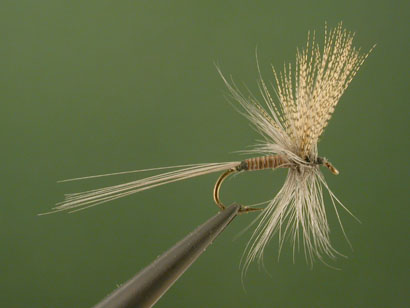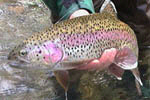|
|
|
Story By: Eric
Austin
Fly Tied By: Eric
Austin
Recipe
By: Traditional
Home: Delaware,
Ohio
E-mail: eaustin2@columbus.rr.com |
Born in
the Adirondacks of New York, Eric fished many famous trout
waters as a youngster and was greatly influenced by local
legend Fran Betters. Once a professional musician, Eric now is
an electronics technician in the hospital communications arena
and freelances when it doesn't interfere with his fishing and
tying. |
|
The
Bridge
|
|
The source of the Salmon River, as far as
I know, starts in a big pond located in Macomb Reservation, above
Schuyler Falls, New York. Now Iím not talking about the great big
Salmon River that everyone knows about thatís located in the Western
part of New York state, the one where fisherman go after huge
steelhead. Iím talking about the little tiny Salmon River, located
not too far from my hometown of Plattsburgh, N.Y., where fishermen
go after diminutive stocked Browns. Anyway, the Salmon River starts
at Macomb Reservation, plunges two miles or so down a hill, roars
into the town of Schuyler Falls, under the main street, goes down a
series of 6" deep rapids, meanders slowly through flat farmland all
the way to the town of Salmon River (near the Tasty Freeze), from
where it then barely moves through a fever swamp, finally petering
out at Lake Champlain, by the Royal Savage restaurant. I know about
the fever swamp because I fished the entire five miles of it one day
with my friend Bruce Copeland, and am still trying to shake the
Malaria. That is, however, another story.
Like most kids in our area, I had
done some fishing on Lake Champlain when I was younger. This
typically involved going out in a rowboat at about 6 a.m., in the
freezing cold, and fishing for perch with worms. I didnít like
getting up early, I didnít like the cold, I didnít like worms, and I
didnít like sitting around in a boat. It was
boring.
Later though, I discovered stream fishing. This I
liked. You could move around. There was freedom, freedom from
parental oppression, freedom to explore, freedom to do what you felt
like doing, when you felt like doing it. You didn't have to get up
at 6. You could roam, almost aimlessly. I liked aimlessly. The
fishing was more technical. We had spinning rods, and they were much
cooler than the bait casting rods of lake fishing. You could buy
esoteric lures, you didnít have to fish with worms if you didnít
want to. The lures were three in number. The Daredevil spinner (a
red and white barber pole spiraled spoon), the Mepps spinner (all
the way from Norway), and a plain spinner (the least expensive). If
there were any other lures out there for Trout, we were blissfully
unaware of them. I never actually caught a Trout on a spinner, but I
spent days trying. I could get one on a worm every once in awhile,
but I wasnít too wild about worms. I needed something else.
Then I heard about fly-fishing. I had seen a man fly-fishing once in Cape Cod. I
knew there were wet flies and dry flies. Thatís all I needed to
know. I bought two flies at Montgomery Wards, a Royal Coachman and a
Quill Gordon, a wet fly and a dry fly, the prettiest fly and the fly
with the coolest name. I was ready.
This particular day was probably in June.
I was about 14 or 15 years old, and it was the very early Sixties.
Two friends and I had been fishing the slow moving, meandering part
of the Salmon River that wandered through North Country farm
meadows. It was just warm enough that you felt like running around,
aimlessly, and we did a bit. But our aim this day was to fish the
bridge, and ultimately we wound up there.
One of us had actually caught a fish off
this bridge once (not me), and so we considered it a prime spot. The
bridge was an old iron two-lane affair that crossed the river and
served no useful purpose that we could discern. It was off the main
road, on a side fork, and connected to nothing in particular. The
fact that this was a bridge to nowhere didnít concern us a whole lot
this particular day, because from the vantage point of the bridge we
could see trout milling around down below. We got excited. We were
pumped. These trout were ours!
The excitement wore off some in the next
hour or so however, when we hadnít gotten so much as a nibble. We
were literally bouncing worms off these trout's heads to no avail.
The sun was directly overhead, it was a clear, beautiful Spring day,
and conditions for catching trout off a bridge couldnít have been
much worse. The good news was, we didnít have a clue that conditions
were bad. All we knew was the fish werenít biting right now. Nobody
was there to tell us that we couldnít catch fish, so we assumed we
could.
I decided to fly-fish. After all, I had
two flies. Someone had told me that to fish a dry fly you drifted
it, on the surface of the water, over a troutís head. So I tied my
Quill Gordon, about a size 14 I would guess now, to the end of the
10-pound test line on my spinning reel. I carefully lowered it down
off the bridge, and put it in the water just upstream of a fish. I
have learned recently that this technique is called "dapping", but
as far as I was concerned, I was fly-fishing. Little did I know that
to fly-fish you need an $800 rod, a vest, waders, felt-soled boots,
floatant, leaders, a $400 reel, and a guide. At least now you do.
When youíre 14 you donít.
I can still see clearly in my mind the
fly drifting down, right over the trout, and the trout coming
up lazily and taking it, almost effortlessly, in slow motion. I
suffered immediate cardiac arrest. My heart rate jumped to ten times
normal, and I started screaming, "I got one! I got one!" With a
mighty heave I set the hook, jerking the fish clean out of the
water, slamming him against the side of the bridge which resounded
with a mighty KAWANGGGG! The fish was killed instantly by the blow,
and I was now furiously pulling him up, hand over hand, my spinning
rod in a heap behind me. All the way up I kept thinking "heís going
to get off, heís going to get off", but the old iron bridge had done
its work, and his struggles were over. I pulled his cold, lifeless
body over the top rail of the bridge and pounced on my prize. A
ten-inch beauty, and caught on a fly! I was now at the pinnacle of
fishing, fly-fishing, there were no more worlds to conquer, and I
was hooked for life. The bridge that connected nothing to nowhere,
had brought me to my destiny.
--Eric Austin 7/3/01
|
Quill Gordon as tied by Eric
Austin |
|

Photo by Peter Frailey
|
Order of Ingredients:
Hook: Size 12
to 18, standard dry fly (Mustad 94940 pictured
here).
Thread: Black 8/0 to
12/0.
Wing: Wood Duck.
Tail:
Medium blue dun hackle or Dun Coq de Leon (used in this
example).
Body: Stripped peacock
quill.
Hackle: Medium blue dun rooster saddle or
neck hackle. |
|
|
|
copyright © Notice by fishingwithflies.com.
All rights reserved. This
material is for your personal enjoyment. Please obtain prior
written permission from the author and fishingwithflies.com
before any other
use. |
| |



